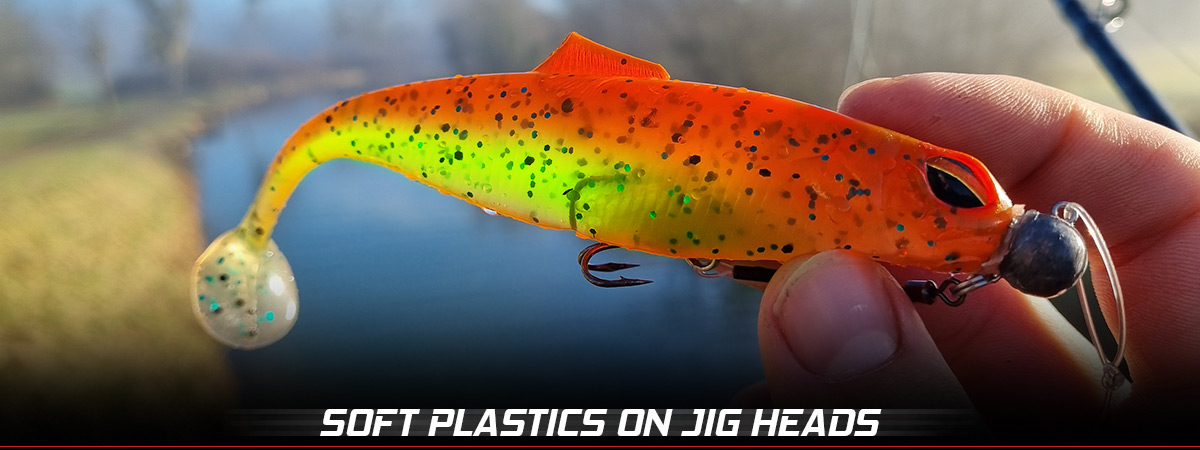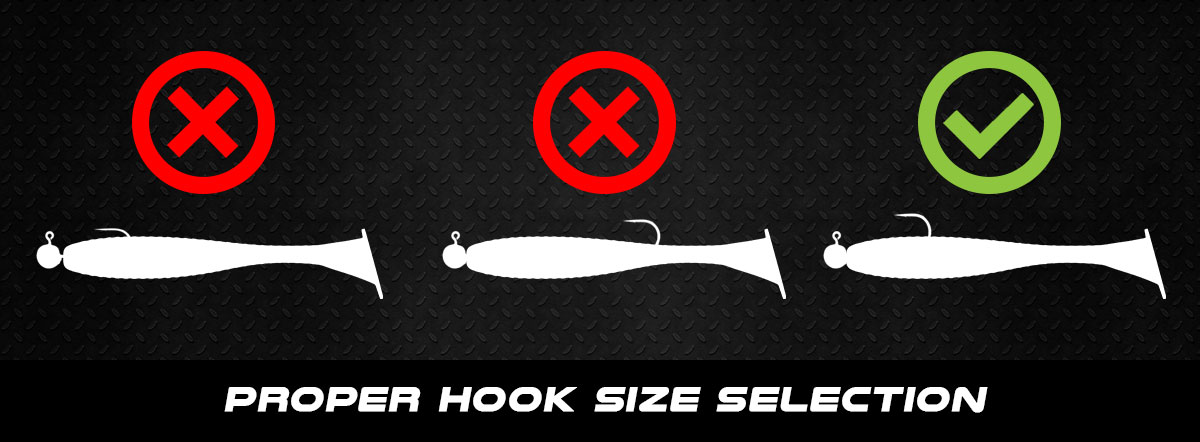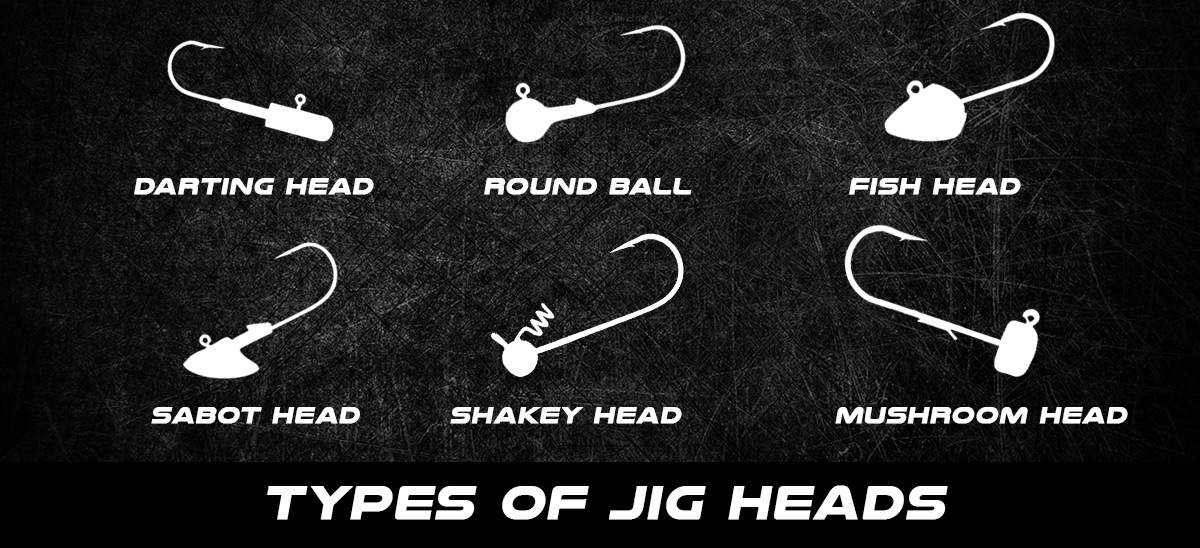
Rigging soft plastics on jig heads is the most basic and simple way to fish soft baits. Just thread it on and you’re good to go. The end! In a nutshell that’s it, but there’s a little more to it than that. With fishing tackle, success or failure often is found in detail. So after the posts on the Texas rig and drop shot, let’s take a closer look at fishing with soft plastics on jig heads.
A jig head is a long shank hook with lead weight molded around it. It often includes a device to keep the plastic from sliding down the shank. It can be a collar or a little wire. But let’s focus on the hook for a moment.
The first obvious element is the length of the hook shank. It needs to match the lure it will be rigged on. Most soft plastics have a body and a tail part. The idea is that the hook needs to be about 1/3 of the length of the body. It can be tempting to choose a long hook to prevent short strikes misses. But the whole point of fishing soft bait is that it’s soft. If it’s impaled by a long hook it loses its softness.
Keep in mind most game fish aim for the head of their prey. I prefer to err on the side of too short than too long. It might seem counter-intuitive but you can’t miss the bite that never happened because the lure seemed too clumsy. Make sure you also use a wide enough gap in such a way that most of the bend is outside of the lure body.

An often-overlooked element of soft plastics on jig heads is the hook wire size. Manufacturers make jig heads with light and heavy wire hooks, unrelated to the hook size and head weights. The gauge you choose needs to be related to your line size.
A light wire will penetrate the fish’s mouth with very light effort. It’s a good choice if you’re fishing a light line because the light line will limit how much pressure you will apply when setting the hook. In other words, you can only set the hook gently, so the hook needs to penetrate easily. While battling the fish, you will have your drag set at a low poundage and will apply only a little pressure on the fish. Because of that, the hook will not bend and open.
On the other hand, if you’re fishing with a heavy line, you can pull hard on the hooked fish and open a light wire jig hook. Therefore it’s better to select a heavy gauge hook. It won’t penetrate as well, but you can afford a manly hook set without fear of breaking the line. Light wire hooks are great for trout, perch, and zander while heavy-gauge hooks are better suited for bass, pike, and saltwater species.

We’re not done with hooks yet! The final element is the eyelet angle with the shank. The standard most common is 90°. It’s great for most situations, and if that’s all you have in your box you’re fine. Some jig heads have a wider angle. Along with weight distribution, they are designed for open water swimming rigs. It will help keeping the lure on a more horizontal posture for a more natural presentation.
There’s an almost infinite number of shapes for the head. And before listing the most common, let’s just discuss how to select the weight. My rule of thumb is to select the lighter I can get away with. First, because it will appear more natural to the fish, they don’t feed on fast sinking rocks!
When a fish bites, it creates a suction, pulling water and the target with it. If the lure is all lead it won’t move and the fish will just get water. Also, heavyweights tend to snag the bottom much more.
So, depending on line size, target depth, lure size, and volume, select the weight that will get you there in a reasonable time, but no more. Resist the urge of that extra sensitivity and the quick trip to the bottom heavyweights achieve. It will cost you bites.
Round head: the best-selling classic works in pretty much every situation, for every fish species. Can’t really go wrong with that. It’s the best for finesse presentation, in rivers and streams.
Sabot head: with the extra-low center of gravity it’s a very stable head design. It will lay on the bottom without rolling. It’s the perfect design for vertical fishing. Regardless of the soft bait used it will remain horizontal when held mid-depth under the boat. The wedge design means it will snag very easily, not for dragging on the bottom.
Fish head: This is the perfect design for swimming paddle tail swimbaits. It will closely resemble a baitfish with an oversized eye. Again not for dragging the bottom, it’s for open water steady retrieves.
Football head: designed in America they look more like a rugby ball to us in Europe! This is the perfect design to drag soft plastics on a jig head on the bottom. The rig is with a crawfish imitation, drag it or hop it on the bottom. The weight distribution also creates the kicking action typical of a crawfish trying to escape.

Mushroom head: old design, it looks like; you guessed it, a mushroom. It had fallen out of favor but knows a revival now with the popularity of the ned rig. The idea is that it will stand vertically on the bottom. Having a floating lure helps a lot too. This is a finesse presentation, just drag and gently hop on the bottom.
Darting head: these jig heads have most of the weight forward of the line tie. They are usually shaped like a rifle bullet, pointed anyway! This shape and balance will allow the angler to get the lure to jump side to side and dart forward, hence the name. It’s best to rig a finesse shad or fluke type soft plastics for the best action. It’s very efficient for fishing for schooling fish in open water or in saltwater.

Wacky head: I don’t know if that falls under the jig head or weighted hook category. Regardless it’s a short wide gap hook with a very small weight. It’s designed to hook in the mid-portion of a worm. A very good technique for bass fishing around vertical structures such as boat docks.
Shaky head: another bass technique, it’s a jig head with a longer hook designed to be rigged with a straight tail worm much like a Texas rig. Some have a little corkscrew device for fastening the worm head. It’s meant to be dragged and shook on the bottom. It’s a great technique for bass and perch alike.
Probably the easiest and simple technique, it pays to look out for details and have a proper presentation. Soft plastics on jig heads are the best way to catch fish wherever you go. Largely inexpensive, make sure you have a wide variety of sizes and weights to cover every situation.